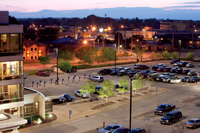
Healthcare facilities are expected to deliver quality, safe environment for residents, visitors and staff, while meeting demands of operations budgets. Costs associated with lighting – from maintenance to energy savings – are often one of the leading budgetary issues for long-term care facilities.
According to a study by the Berkeley National Laboratory, lighting accounts for approximately 22% of long-term care facility operation costs – the second highest expense following water utilities.
Fortunately, a new age of lighting is helping facilities reduce those expenses, while simultaneously helping to improve the environment. Facilities can easily upgrade from outdated fixtures to eliminate poor illumination, and high maintenance and energy costs.
Specific spaces facilities managers and building owners should pay close attention to include: Parking lots, pedestrian walkways and building facades. These areas tend to have heavy pedestrian traffic, and lighting is crucial for visual comfort, wayfinding and security.
From long-term care facilities to hospitals, healthcare facilities are looking to LED lighting to solve issues in outdoor lighting. Crisp, uniform LED lighting – with good balance of vertical and horizontal illumination – makes it easier for patients and visitors to see, aiding in safe, secure, nighttime navigation for pedestrians and vehicles. Improved quality of light is essential, particularly for older residents who experience vision changes related to the aging eye.
Case in Point
Sustainability is not just a buzzword for the ThedaCare Health System in Wisconsin.
In late 2013, a facilities energy reduction team noticed that the outdoor lighting on some of the ThedaCare campuses was more than overdue for an upgrade. Weathered high-pressure sodium (HPS ) and metal halide (MH) fixtures illuminated parking lots on multiple campuses, which emitted harsh, uneven lighting.
As a first step, the lighting team targeted the system’s Theda Clark and Appleton Medical Center campuses. Both campuses feature large parking lots, one slightly more than 861,000 square feet (Theda Clark) and the other, approximately 916,000 square feet (AMC). AMC also utilizes a parking deck with parking ramps on four decks totaling 141,520 square-feet.
The Theda Clark campus is located in a residential area, and facilities managers received multiple complaints from neighbors about lighting overflow from the parking lots on and into houses. Additionally, the pole lighting was comprised of two fixtures per pole, which required Theda Clark to hire electricians to replace the bulbs every three years. The dual heads also created hot spots and dark corners throughout the parking lots – creating a safety concern on the campus.
ThedaCare worked with Élan Lighting’s design team and determined outdoor lighting would indeed be a good upgrade opportunity because of its quick return on investment. To further maximize investments, the team evaluated LED lighting.
Not Just About the Energy
While the decision to go LED was largely driven by the energy savings, ThedaCare also made security a top priority. Healthcare campuses are constantly seeing foot traffic from new patients as well as visiting family and friends. The campuses need proper illumination for safe navigation and wayfinding. And, new lighting could provide better visibility both on-site, as well as through security cameras.
With the poor uniformity of the existing metal halide and HID lighting, the picture on security cameras was below par. Apertures were adjusting to lighter areas, but did not adjust well for visibility in the darker areas. ThedaCare knew the uniformity benefits of LED lighting could help solve this problem.
Once LED was determined as the best light source, the next step for ThedaCare was to identify a fixture that achieved their longevity, energy efficiency, visibility and uniformity goals – all in one affordable solution.
Retrofitting for Sustainability
With the help of Élan Lighting, ThedaCare selected products from the Lithonia Lighting® D-Series LED family from Acuity Brands® for both sites. By replacing the old metal halide and high-pressure sodium fixtures with new D-Series LED luminaires, ThedaCare achieved a more effective and even light distribution. The enhanced uniformity the new LED lighting provides allows security cameras to have a clearer picture when scanning the parking lots.
D-Series LED Area luminaires were installed in parking lots on both campuses. AMC also installed D-Series LED Wallpacks, D-Series LED Floodlights and D-Series LED Parking Garage luminaires.
D-Series LED luminaires offer visually comfortable illumination for drivers and help increase energy efficiency and security, while reducing the maintenance burden of the hospital system. Additionally, improved light uniformity provided a brighter space that is actually less invasive to the neighbors near the campuses’ parking areas. Because the light is much more focused, the spill into surrounding neighborhoods is eliminated. Lights are mounted high enough that it does not affect drivers’ sight or disperse light outside of the ramp.
Another advantage of LED is it dramatically reduces maintenance time and costs. The new LED luminaires can deliver a 100,000-hour expected service life, or up to 10 years of operation, as opposed to the three-year maintenance cycle before the retrofit. Additionally, with the new distribution patterns of the D-Series Area LED luminaires, Thedacare was able to reduce the number of luminaires it needed to light its spaces.
 For the Theda Clark project, ThedaCare was able to reduce the number of fixtures from 84 (original fixtures) to 60 D-Series Area LED luminaires. There is a vast difference between the newly lit lots with a more even distribution, and the yellow from the old lights that casted an unfavorable glow.
For the Theda Clark project, ThedaCare was able to reduce the number of fixtures from 84 (original fixtures) to 60 D-Series Area LED luminaires. There is a vast difference between the newly lit lots with a more even distribution, and the yellow from the old lights that casted an unfavorable glow.
Over a 10-year span, the Theda Clark project is projected to save the ThedaCare campus more than $89,500 in energy costs and more than $58,600 on maintenance.
The AMC parking lot and garage retrofit is projected to save more than $25,000 each year because of the energy reduction. A tribute to the savings achieved with the D-Series luminaires – the Lighting Energy Efficiency in Parking (LEEP) Campaign selected the AMC parking project as the winner for the “Highest Percentage Savings in a Retrofit at a Single Parking Structure.”
The LEEP Campaign effort is a collaboration between the Building Owners and Managers Association International, the Green Parking Council and the International Facility Management Association. It is a recognition and guidance program that encourages facility owners and managers to take advantage of savings opportunities from high efficient lighting solutions in their parking facilities.
Additionally, the parking lot installation is estimated to save ThedaCare $6,500 in maintenance costs and will achieve a 5-year return on investment.
Why Outdoor LED Lighting for Long-Term Care Facilities
The D-Series family of outdoor LED luminaires from Lithonia Lighting® delivers outstanding photometric performance, long-life and energy efficiency in a stylish, easy-to-specify collection that will suit any outdoor application.
Featured benefits include:
- Several luminaires styles available (wall packs, area lights, bollards, and floodlights) to maximize versatility.
- Luminaires can save up to 80% in energy when replacing HID luminaires.
- Using LED technology and precision-engineered optics, the luminaires distribute light more evenly than traditional luminaires.
- The luminaires can be ordered with an integral motion and ambient sensor to deliver increased energy savings.
- The expected service life is more than 100,000 hours.
Just like the Thedacare system, long-term care facilities need to ensure that residents, staff and visitors have appropriate lighting in parking facilities and high traffic areas for wayfinding, safety and visual comfort. Better quality lighting makes it easier for patients and visitors to see, and could help eliminate slips and falls, car accidents and help create a safe environment. On the operations side, facilities managers can reap benefits of LED lighting from a cost reduction standpoint – achieving reduced energy efficiency maintenance costs.
Karyn Gayle, Vice President – Healthcare Vertical, Acuity Brands. Visit http://www.lithonia.com to learn more.



